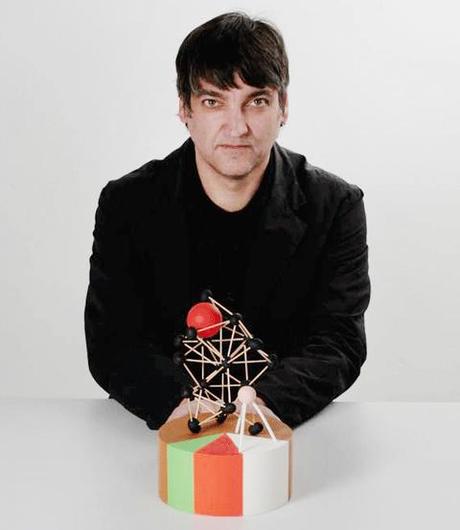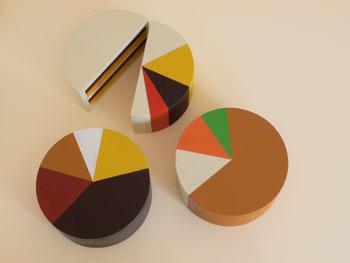
The designer with food design menu #05. Photo by: Imagekontainer
I wish we were meeting for a meal rather than here in the lounge. Do you ever play with your food at mealtime?
No, no. It's very conceptual work. It's this idea of looking at food as an object and then making a design project with usability, economy, all these parameters.
Okay, of course I can play. Actually most of the objects are models.
In the mid 90s I was very interested in mass production. Our lifestyle is changing. We eat in front of the computers. Why does food have to be so conservative and so traditional?

Prototypes of I-cakes, 2001. The pie graphic indicates the ingredients of the cake in percentages. Photo via food-designing.
The whole industrial food that some people call food design, is engineering foods. It’s done to improving manufacturing. In a way it's not ethical, it's not healthy, it's just cheap. Food design should be something that is very good for you.
At the beginning it was very strange for food magazines, but now it's really booming. I've already closed it as a concept in 2001. Still I am doing things, but it's always the same thinking, just new pieces.
So in theory food design is not influenced by any particular culinary history. Yet you live in Barcelona and Berlin, which both have strong food cultures. Don't these cities, and the meals they serve, influence your choices?
Barcelona has a very strong food culture. Of course I follow what's happening in food. And I know most of the chefs in Spain and Italy.
In the Transition Menu book, it's very clear that gastronomy goes into tapas, because it's a kind of production. And it goes into food design. It’s logical sequence. Barcelona is a kind of tapas paradise.
In Berlin, the food is much more of the north. The perception of food is not so much pleasure; it's more functional.

Can you tell me about your new project, the Transition Menu?
Last year I did a project that didn't work for a film based on a chef. I was working on a kind of menu, which was very strange for me because I work in food design but not in gastronomy. I was thinking of this idea that a chef quits gastronomy, and then starts with food design. I have this theory that gastronomy is obsolete.
The Mart asked me to do a project. So I was thinking, I will take this project of the transition menu. Transition because it goes from gastronomy to food design. It's a kind of menu where you feel that gastronomy is no longer interesting.
I did this menu of 23 elements that define the borders of gastronomy and food design. That’s presented in the museum in Italy and in the book.
What are some of those 23 elements?
For example, instead of having a plate like that [holds horizontally], you have a plate like in the museum [holds vertically]. It's a kind of mousse that sticks. The ingredients are all healthy and make sense with the character.
How do you choose your materials? Do you use all the senses to select the items?
I work with several people who help me with the ingredients. Chefs, food engineers, dieticians. Food has a certain complexity.
For me, the least important things are the taste, smell, or texture. Those are things for a chef. I make a context to the food. And then I design a ritual: how you have to eat it, or why you have to eat it. I set some parameters, like it has to be fresh, or it has to help you remember.
